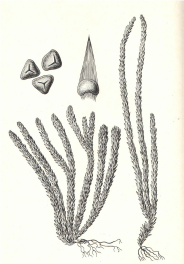FAMILY HYPERZIACEAE
The poisonous Lycopodium selago, or fir clubmoss, is an evergreen perennial herbaceous plant.

The sporophyte differs from the previously described species in its growth form. It produces several clustered erect stems, 5–25 cm tall, dichotomously branching. The stems are densely covered with linear-needle-like leaves, with the lower part of the stems being bare and brown. All leaves are uniform, horizontally spreading or upward-pointing but not pressed, hard, sharp, entire-edged, occasionally finely serrated, shiny, and 5–7 mm long and 1–1.5 mm wide. No spore-bearing cones are formed; spores are located in sporangia, visible only under a magnifying glass, found individually in the axils of green leaves. The sporangia are kidney-shaped, up to 1 mm long and 1.5 mm wide, and are located in the upper and middle parts of the plant.
It grows in mossy coniferous forests in the northern forest zone, less frequently in the Caucasus and Carpathians.
In medicine, the herb Lycopodium selago (Herba Selagins) is used. The herb is harvested throughout the summer. Dried herb consists of green stems with leaves. The stems are up to 20 cm long, with shorter stems predominating since they easily crumble after drying. The raw material resembles the herb of Lycopodium annotinum.
Microscopic examination reveals a white fringe with papillate outgrowths along the edge of the leaves of Lycopodium selago, unlike other species such as Lycopodium clavatum or Lycopodium annotinum. This fringe consists of adjoining cells of the upper and lower epidermis, under which no green mesophyll cells are present.
The herb of Lycopodium selago contains 0.6–1.1% alkaloids, which likely accounts for its toxicity to animals and humans. Seven alkaloids have been identified, with the main one being selagin. Overdosing on fir clubmoss can lead to fatal outcomes.
A 5% aqueous decoction of Lycopodium selago is used in medical practice for treating chronic alcoholism. The treatment induces a conditioned reflex aversion to alcohol through unpleasant effects caused by the decoction.
The decoction causes strong vegetative reactions such as salivation, sweating, lowered blood pressure, changes in pulse, respiratory slowing, muscle fibrillation, general malaise, prolonged nausea, and repeated vomiting (sometimes more than eight episodes). Nausea intensifies if the patient consumes alcohol or smokes tobacco. By repeatedly pairing alcohol intake with the decoction, a conditioned reflex aversion to alcohol is developed.
Treatment is conducted only in specialized healthcare facilities under medical supervision and is generally combined with psychotherapy. Treatment begins 3–4 days after stopping alcohol consumption. Patients consume half a glass (about 100 ml) of freshly prepared 5% decoction, and after 3–15 minutes, are given 3–5 ml of their preferred alcoholic beverage to drink and smell. Vomiting occurs within 10–15 minutes or sometimes later, 1–3 hours after ingestion.
Adverse effects of the decoction may include abdominal pain, fainting, or collapse. Treatment with Lycopodium selago is contraindicated in patients with endocrine disorders, severe cardiovascular diseases, respiratory diseases, gastrointestinal ulcers, and various other conditions.
A 5% decoction is prepared by placing 10 g of crushed herb into a flask, adding 200 ml of water, and boiling for 15 minutes on low heat. The decoction is cooled, the herb squeezed, water added to make 200 ml, and then filtered. The decoction is stored in a refrigerator for no more than two days.
